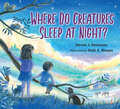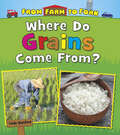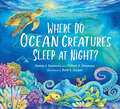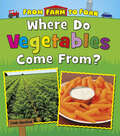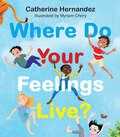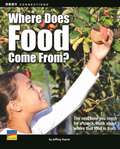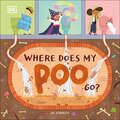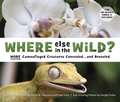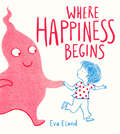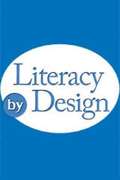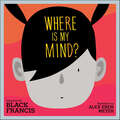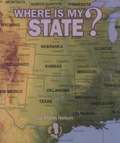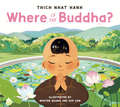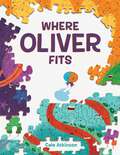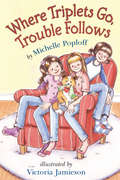- Table View
- List View
Where Do Creatures Sleep at Night?
by Steven J. SimmonsAnimals sleep, just like you! But where? And how? Let's take a look at what creatures do / when you are asleep and the day is through . . .We're used to seeing animals during the day, but where and how do they sleep at night? From butterflies to bees and frogs to fish, from birds to horses and squirrels to bunnies, plus cats and dogs, this sweet book in rhyme shows kids where animals bed down while kids are also asleep. Following a brother and sister on a farm where all the animals can be found, this book teaches and delights!
Where Do Diggers Celebrate Christmas? (Where Do...Series)
by Brianna Caplan SayresIf you love Where Do Diggers Sleep at Night? and its things-that-go sequels, now you can join your favorite trucks as they celebrate Christmas!What do diggers and tractors and forklifts and tankers do to get ready for the holidays? The same things that your family does! From trimming the tree and singing carols to gathering gifts and putting out milk and cookies for Santa, Christmastime for the beloved vehicles of Where Do Diggers Sleep at Night? looks a lot like yours. Even Zambonis celebrate . . . on ice! Enjoy the rollicking rhymes as you watch the truck families prepare for Santa and even help pull his sleigh! Children who can't get enough of trucks will love Brianna Caplan Sayres's things-that-go holiday story.
Where Do Grains Come From? (From Farm To Fork: Where Does My Food Come From? Ser.)
by Linda StanifordThis fascinating book looks at how grains are produced, taking the rice we eat as an example. Engaging text and beautiful, color photographs show readers how rice is planted, grown, then harvested through a long journey to end up on our plates.
Where Do I Live?
by Ann W. Iosa Neil ChesanowChildren will gain a whole new understanding of the world we live in with this fun, first-look at geography. This engaing picture book is like a mini virtual globe for kids! Starting in their bedrooms, children will travel outside for a look around the streets of their neighborhood. Then, they'll zoom out for a bird's eye view of their town, city, suburb, and countryside. They'll move out even further for a view of the states, the country, and the different continents. The next stop is space, for an exciting look at our solar sysem and universe! From there, they'll trace their way home again. A fun mini quiz in the back lets kids show off what they've learned about where they live.
Where Do Jet Planes Sleep at Night? (Where Do...Series)
by Brianna Caplan SayresThe same team that brought you Where Do Diggers Sleep at Night? and Where Do Steam Trains Sleep at Night? have created another high-flying bedtime story—this one for plane enthusiasts!Have you ever wondered what little airplanes do when it&’s time for bed? Jumbo jets, biplanes, helicopters—even Air Force One!—power down, wash up, and listen to stories with mommy and daddy planes beneath a blanket of stars, getting ready to fly to dreamland. Little airplane lovers will be tickled to see how bedtime is just the same for their favorite flying vehicles as it is for them, as they come down to earth for sleepy time. "Combining a quiet, nocturnal story with the ever popular subject of flying machines, this is a nifty bedtime book for budding aviators." —Kirkus Reviews
Where Do Ocean Creatures Sleep at Night?
by Steven J. Simmons Clifford R. SimmonsOcean animals sleep, just like you! This informative, rhyming picture book dives deep to look at where and how ocean animals sleep in the sea.Many ocean animals are active during the day, but where and how do they sleep at night? From sharks to dolphins and sea turtles to octopuses, plus parrotfish and whales and more, discover what these ocean creatures do when it&’s time to go to sleep and the day is through.Where Do Ocean Creatures Sleep at Night? is newest addition to a three-book series, which includes Where Do Creatures Sleep at Night? and Where Do Big Creatures Sleep at Night? "Where Do Ocean Creatures Sleep at Night showcases wondrous watercolor illustrations that capture the allure of the sea. The rhyming rhythm dances through captivating animal facts about water-dwelling creatures before concluding in a cozy child's bedroom. Crafted to be a favorite bedtime read, this book is a must-have for the bookshelves of ocean lovers.&”– Bethany Stahl, Bestselling Author of Save the Ocean&“All mammals and most other animals need sleep, including those living in marine environments. This picture book&’s palette of soft colors and informative rhyme will introduce children to various facts about specific ocean animals and how they rest. Perfect for a bedtime read-aloud, this book will help young listeners and readers cuddle up together in their nice dry bed and sleep as tight as otters.&”– Sara T. Behrman, former librarian and author, The Sea Hides A Seahorse&“A delightful bedtime book! This jaunt into the ocean to learn about how our marine friends sleep will easily become part of your family bedtime routine. The charming illustrations are sure to captivate the imagination of children and inspire a love for the wonders of the sea, while sending them on a happy trip to dreamland.&” – Anne Richardson, Author of Octopuses Have Zero Bones and Chief Experience Officer at The Exploratorium "Scientific, sweet, and salty!"- Karen Romano Young, Deep Sea Diver and Award-winning Author of Whale Quest "This book is an absolute delight- the Dr. Seuss Sleep Book reimagined for the ocean. A beautiful way to unwind while learning a little more about our mysterious watery world. Where Do Ocean Creatures Sleep at Night? will surely inspire a future marine biologist or two!"- Paige Hoel, Ph.D. candidate, Oceanography, UCLA Atmospheric and Oceanic Sciences"A gorgeously illustrated children&’s book that will inspire the next generation of marine biologists, conservationists, and animal lovers. The accurate animal facts were a breath of fresh air to find in this genre and will make learning fun for children and adults alike!&”- Kristyn Plancarte, Marine Biologist and animal trainer&“Dive into an underwater world of wonder and imagination. This delightful read features stunning artwork that brings the ocean to life for bedtime. From playful dolphins to sleepy sea turtles, families will climb aboard an informative journey through the sea." - Kendra Nelson, Marine Conservationist
Where Do Polar Bears Live?
by Sarah L. ThomsonLet's-Read-and-Find-Out about Polar Bears. The Arctic might be a bit too chilly for you or me to live there, but it is the perfect home for polar bears. The fur between the pads of their paws keeps them from slipping on the ice. Their skin and blubber are like a warm blanket. But the earth is getting warmer and the ice is melting. Where will the polar bears live? How can we help protect their home? Read and find out! <P><P>[This text is listed as an example that meets Common Core Standards in English language arts in grades 2-3 at http://www.corestandards.org.]
Where Do Speedboats Sleep at Night? (Where Do...Series)
by Brianna Caplan SayresFrom the team that brought you Where Do Diggers Sleep at Night? comes another "things that go" bedtime story, and this one is all about boats and sailing off to dreamland!Ahoy there! Have you ever wondered what little speedboats do when it's time for bed? The same things you do! Cruise ships, canoes, fishing boats--and more!--wash up, have a snack, stow their teddies for storytime, and get "docked" to sleep by mommies and daddies, once the tides calm. Children who can't get enough of boats will love this nautical nighttime story full of exciting and familiar watercraft. Little vehicle lovers will want to collect all the books by Brianna Caplan Sayres and Christian Slade, including Where Do Steam Trains Sleep at Night?, Where Do Jet Planes Sleep at Night?, and Where Do Diggers Celebrate Christmas?
Where Do Steam Trains Sleep at Night? (Where Do...Series)
by Brianna Caplan SayresThe same team who brought you Where Do Diggers Sleep at Night? have engineered another rollicking bedtime story—for train lovers everywhere! Have you ever wondered what little trains do when it&’s time for bed? The same things you do! Freight trains, passenger trains, subways, trolleys—and more—wash up, have a snack, load their teddies for story time, and get rocked to sleep by mommy and daddy trains beneath a blanket of stars. Little train lovers with a one-track mind will gain a new affinity for their bedtime routine when they find they share it with their favorite vehicles. &“Sayres and Slade move naturally from their truck lullaby, Where Do Diggers Sleep at Night? , to this nighttime serenade to all things train. Hopeful engineers will want to be able to identify the many different types of trains, and their out-of-the-know adults will appreciate this inclusive primer.&” —Kirkus Reviews
Where Do They Go?
by Julia AlvarezBestselling novelist (How the Garcia Girls Lost Their Accents) and children's (The Tia Lola Stories) author Julia Alvarez's new picture book is a beautifully crafted poem for children that gently addresses the emotional side of death. The book asks, "When somebody dies, where do they go? / Do they go where the wind goes when it blows? ... Do they wink back at me when I wish on a star? Do they whisper, 'You're perfect, just as you are'? ..." Illustrated by Vermont woodcut artist, Sabra Field, Where Do They Go? is a beautiful and comforting meditation on death, asking questions young readers might have about what happens to those they love after they die.A Spanish-language edition of the book, ¿Donde va a parar?, is available in paperback.
Where Do Vegetables Come From? (From Farm To Fork: Where Does My Food Come From? Ser.)
by Linda StanifordThis fascinating book looks at how vegetables are produced, taking the carrots we eat as an example. Engaging text and beautiful, color photographs show readers how carrots are planted, grown, then harvested through a long journey to end up on our plates.
Where Do Your Feelings Live?
by Catherine HernandezA picture book about how we can show love to difficult feelings, from the acclaimed author of M Is for Mustache: A Pride ABC Book and I PromiseWhen you’re someplace unfamiliarHow do you feel?Does your feeling live in your tummy where strange creatures roam in fields of prickly grass? Does it want to burrow its head deep in the sand where no one can find it?In Catherine Hernandez’s new picture book, young readers are encouraged to show compassion to themselves, their families and their communities, and to imagine where inside themselves they keep their feelings. Championing young people for weathering the storms of their many emotions and trying their best, Where Do Your Feelings Live? is a gentle celebration of all the tricky feelings that make us who we are. This buoyant and touching text is brought vibrantly to life by illustrations from Quebec artist Myriam Chery.
Where Does My Poo Go?
by Jo LindleyEver wondered what happens when you flush the toilet after you&’ve gone number 2? Let&’s dive in!Get ready to embark on an epic journey! Perfect for curious kids, this fascinating illustrated book takes young readers underground through each stage of the sewage system. Where Did My Poo Go? In just one flush, it disappeared! It might seem like magic - but there&’s a lot more going on than meets the eye! This one-of-a-kind picture book provides kids with an introduction to what happens to their poo once it is flushed down the toilet. Follow your number 2 through the smelly sewers and discover what happens next! From being turned into sludge at the water treatment plant to being recycled and turned into electricity, this adorable book for preschoolers will keep your little one engaged and entertained! It&’s a must-have for parents and educators interested in teaching their kids about waste and recycling. Hold your Nose and Jump!Packed with age-appropriate text, fun facts, and bright, humorous pictures, this delightful educational book goes behind the scenes of a topic that most kids know little about. It&’s a wonderfully unique book for kids who are entertained and fascinated by poo.
Where Else In The Wild?
by David M. Schwartz Yael Schy Dwight KuhnDid you find that sneaky orchid mantis hiding on the cover? This book is full of similarly sly species-and they're all hiding in plain sight. Think you've spotted one?<P><P> Lift the flap to find out Each of the camouflaged creatures on these pages, from chickadees to crayfish, is disguised for a reason.Some are on the prowl for prey, while others hide from hungry predators. Discover why geckos have a spooky reputation; why it pays for a mouse to have a dark-colored back and light-colored belly; and why you wouldn't want to be fooled by a scorpion fish.<P> In this follow-up to the acclaimed Where in the Wild?, David Schwartz, Yael Schy, and Dwight Kuhn take readers on another remarkable tour through the fascinating world of animal camouflage.
Where Happiness Begins
by Eva ElandThis follow-up to When Sadness Is at Your Door suggests that happiness can always be found by looking within.This helpful picture book is a great introduction to mindfulness and emotional literacy. A spare text and simple illustrations encourage readers to find happiness even if it feels far away. The book gives it a shape, turning this elusive emotion into something real while acknowledging that you can't be happy all the time. The thoughtful text reassures readers that when happiness is hard to find, they can look for it in many places. Sharing something with a friend or reaching out to someone who needs it can lead to happiness. Recognize and treasure it when you experience it, knowing that happiness begins with you. Perfect for kids and for adult readers tackling these feelings themselves!
Where I Live
by Eileen SpinelliDiana loves where she lives. She loves the astronomy charts on her walls and the fact that she can wave to her best friend, Rose, from her very own window. And best of all, a wren has recently made its home right by her front door! When her family is forced to move, Diana wonders if she?ll ever find that same grounded and happy feeling again. This gentle and ultimately redeeming story in poems is about those secure and fulfilling friendships that happen naturally and easily when you live right next door, and the struggles of losing the comfort of a familiar place. Matt Phelan's warm and expressive illustrations perfectly complement Eileen Spinelli's tenderhearted and unique tale that reminds us that sometimes a little uprooting and change is necessary for growth.
Where Is Fish?
by Abby Seaborne George HamblinThe fun and excitement of English and Language Arts learning continues in Grade 2 of Reading Street. This comprehensive and dynamic curriculum for homeschooling is geared toward young children who have some foundational English and Language Arts knowledge and are ready to strengthen their skills. Comprised of engaging activities, challenging content and weekly quizzes, Reading Street: Grade 2 is the next step in your child's path toward becoming a lifelong learner and reader. As with all Reading Street products, the Grade 2 system is formatted to help students meet certain age-appropriate goals. After completing this English and Language Arts homeschool program, your child should be able to: Read and comprehend two-syllable words. Identify common prefixes (such as pre-, un-, or re-) and suffixes (such as -able, -ad and -er). Correct mistakes made when reading out loud. Read books with two or more chapters. Understand the structure of stores (i. e. beginning, middle and end). Start selecting reading materials based on his/her own interests. Identify the "who," "what," "when," "where," "why" and "how" of the text. While the goals of second Grade English and Language Arts are numerous, Reading Street will help you craft engrossing lessons. Your child will garner important English and Language Arts skills while completing a workbook, reading stories and poems, and taking assessments. Planning these lessons will be easier than ever, as all Reading Street systems are broken down into weekly Big Ideas. All the work your child does on a given week is formulated around that single concept for an organized and challenging curriculum. With six easy-to-follow units, Reading Street: Grade 2 is the perfect tool for homeschooling parents. Your child will enjoy the reading selections and activities, and you'll love to see your student growing into a knowledgeable individual. We're confident that this product is the right one for you. For more information on the specific materials found in Grade 2 of Reading Street, check out the Features and Benefits page.
Where Is My Mind? (LyricPop)
by Black Francis“Where is my mind?Where is my mind?Way out in the waterSee it swimmin’ . . .”Where Is My Mind? is an imaginative picture book based on Black Francis’s lyrics to one of Pixies’ most beloved songs. The song was released on their certified-gold album Surfer Rosa, and later appeared in the film Fight Club.Parents and children alike will delight in following the story of a young girl who loses her mind when she falls off a skateboard, then travels to magical lands in search of it. Brilliantly illustrated by Alex Eben Meyer, Where Is My Mind? is a celebration of creativity, both in song and story.
Where Is My State?
by Robin NelsonFirst Step Nonfiction introduces young children to fun, easy-to-read non-fiction they will read again and again. Supporting beginning readers through repetition and simple sentences that directly correspond to large photographs, this series explores a wide range of everyday subjects -- from trees to time -- while helping develop nonfiction reading skills. Each title introduces a topic relevant to children's everyday experiences while inspiring them to read.With large, vivid photographs and basic, repetitive sentences that clarify the notion of location, this compelling new multicultural series invites beginning readers to discover a whole new world and their place in it.
Where Is the Buddha?
by Thich Nhat HanhA new story for children from Zen Master Thich Nhat Hanh: a young boy named Minh goes on a journey to find the Buddha, only to discover the Buddha is in each one of usMinh loves going to the temple with his parents. Everyone is nice to him there as they go about their daily work. But his favorite part of the temple is the Buddha statue. He is very impressed by all of the bananas, mangoes, and other fruits that people leave for the Buddha. He imagines that the Buddha must really like all of those fruits! To Minh, the Buddha statue is the Buddha.As Minh grows up, eventually he realizes that the Buddha statue isn't actually the Buddha. But if the statue isn't the Buddha, then what is? Where is the Buddha? With his characteristic insight, sincerity, and sense of humor, Thich Nhat Hanh guides young readers through a charming tale of discovery, beginning in India with the story of the historical Buddha, Siddhartha, and then on to Vietnam with Minh and his quest. Includes a section at the end of the book on How to Be a Buddha, with basic breathing exercises and meditations for children.
Where Oliver Fits
by Cale AtkinsonOliver has always dreamed about where he will fit. Will he be in the mane of a unicorn? The tentacle of a pirate squid? The helmet of an astronaut? When he finally goes in search of his perfect place, he finds that trying to fit in is a lot harder than he thought. But like any puzzle, a little trial and error leads to a solution, and Oliver figures out exactly where he belongs. Where Oliver Fits is a sweet and funny story that explores all the highs and lows of learning to be yourself and shows that fitting in isn't always the best fit.
Where Triplets Go, Trouble Follows
by Michelle Poploff Victoria JamiesonThe Divine triplets all have blue eyes, but they're not identical. Daisy plays baseball, Lily writes poems and Violet -- well, Violet's a bit on the bossy side. Still, the sisters support one another when Daisy's in a baseball slump, Violet worries about failing science and Lily's afraid to face her greatest fear. And they quickly join forces trying to uncover a super family surprise that just may lead them straight into trouble.From Divine disasters to chaos and cuddles, readers will love the triplets.
Where We Come From, Where We Go (Reach Into Phonics Ser.)
by Deborah J. Short Juan Medina Jane KincaidNIMAC-sourced textbook
